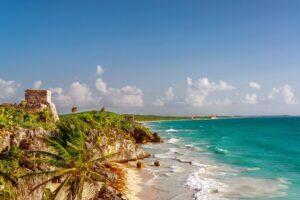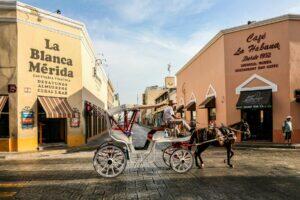Fodor's Expert Review Hochob
This small Maya site is an excellent example of the Chenes architectural style, which flowered from about AD 100 to 1000—though Hochob was occupied roughly beginning around AD 300. Most ruins in this area were built on the highest possible elevation to prevent flooding during the rainy season, and Hochob is no exception. It rests high on a hill overlooking the surrounding valleys. Another indication that these are Chenes ruins is the number of chultunes, or cisterns, in the area.
Since work began at Hochob in the early 1980s, four temples and palaces have been excavated, including two that have been fully restored. Intricate and perfectly preserved geometric designs cover the temple known as Estructura II, which are typical of the Chenes style. The doorway represents the open mouth of Itzámná, the creator god, and above it the eyes bulge and fangs are bared on either side of the base. It takes a bit of imagination to see the structure as a mask, as color no doubt originally... READ MORE
This small Maya site is an excellent example of the Chenes architectural style, which flowered from about AD 100 to 1000—though Hochob was occupied roughly beginning around AD 300. Most ruins in this area were built on the highest possible elevation to prevent flooding during the rainy season, and Hochob is no exception. It rests high on a hill overlooking the surrounding valleys. Another indication that these are Chenes ruins is the number of chultunes, or cisterns, in the area.
Since work began at Hochob in the early 1980s, four temples and palaces have been excavated, including two that have been fully restored. Intricate and perfectly preserved geometric designs cover the temple known as Estructura II, which are typical of the Chenes style. The doorway represents the open mouth of Itzámná, the creator god, and above it the eyes bulge and fangs are bared on either side of the base. It takes a bit of imagination to see the structure as a mask, as color no doubt originally enhanced the effect. Squinting helps a bit: the figure's "eyes" are said to be squinting as well. But anyone can appreciate the intense geometric relief carvings decorating the facades, including long cascades of Chaac masks along the sides. Evidence of roof combs can be seen at the top of the building. Ask the guard to show you the series of natural and man-made chultunes that extend into the forest.
If you're driving from Campeche, take Carretera 180 toward Holpechén and continue until you reach Carretera 261. Follow the road approximately 40 km (25 miles) toward Dzibalchén, then take the dirt road toward the town of Chencoh until you reach Hochob, 15 km (9 miles) ahead.
READ LESS





